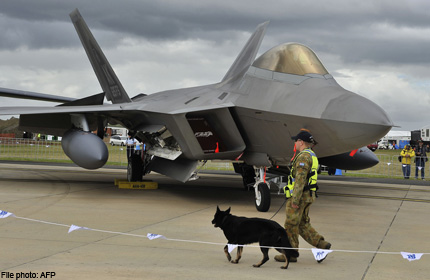
WASHINGTON - High-speed manoeuvres at high altitudes may be the reason some pilots are experiencing oxygen deprivation while flying the F-22, a US Air Force general said on Tuesday, although she insisted 17 new safety measures had made the jets safe to fly.
Lieutenant General Janet Wolfenbarger told a Senate Armed Services subcommittee that recent data was helping the Air Force narrow down its hunt for the root cause of the issue, which prompted a grounding of the F-22, built by Lockheed Martin Corp, for over five months last year.
Wolfenbarger's comments raised questions about whether the new F-35 fighter jets being developed by Lockheed could face similar issues.
The F-22 issue flared this week after CBS's "60 Minutes" programme aired a report in which two pilots said they had stopped flying the fighter due to safety concerns.
Air Force Secretary Michael Donley and Chief of Staff General Norton Schwartz had issued a directive to ensure there was no retaliation against the two "whistleblowers", Wolfenbarger told the subcommittee hearing.
"We are starting to believe that we are coming to closure on that root cause," she said. "We're realising that we operate this aircraft differently than we operate any of our other fighter aircraft. We fly at a higher altitude ... we execute manoeuvres that are high-G at that high altitude. And we're on that oxygen system at those high altitudes for periods of time."
She said the Air Force had implemented over a dozen new procedures to ensure pilot safety. She said 11 incidents of oxygen-deprivation had been reported since F-22 flights resumed, but that was only 0.1 per cent of all flights.
Vice Admiral David Venlet, who oversees the Lockheed F-35 fighter, said his staff had worked closely with the F-22 programme office since the issue first emerged.
The two aircraft have similar onboard oxygen generating systems made by Honeywell International, but the F-35 emergency backup system kicks in automatically, while the F-22 and other US fighter planes have a manual activation switch, Venlet told reporters after the hearing.
"We very much have paid attention to that," he said. "Every time something impacts the life support system ... it's jumped on very aggressively." Venlet said the F-35 and F-22 programmes were carrying out cooperative testing of possible contaminants that would benefit both programmes.
Lockheed said it was working closely with the Air Force to determine the cause of the oxygen issues, and the F-35 programme continuously monitored issues detected on other aircraft.
Pentagon cites progress on F-35 programme
Venlet told the committee a recent restructuring had put the US$397 billion (S$495 billion) F-35 programme on a solid footing, with enough time and resources to complete required developmental testing in 2016, and get fully capable planes to the services in 2017.
He said his office would deliver a detailed scheduled for initial operational testing and evaluation to the Pentagon's acting acquisition chief, Frank Kendall, in September.
Lockheed on Tuesday said the F-35 fighter was continuing to make progress and had now completed about 25 per cent of the programme's entire requirement of more than 59,000 test points.
It said the test programme remains ahead of the 2012 flight test plan, and had completed 373 of the test flights planned for 2012 by the end of April, despite a strike by 3,650 union workers at the Fort Worth, Texas plant and two test sites.
Venlet said the flight line at Fort Worth was still functioning and Lockheed would deliver two production jets to the government this week. Flight testing at Edwards Air Force Base in California and a naval air station in Maryland was also continuing at a "relatively normal pace," he said.
He said manufacturing activity inside the Fort Worth plant was "greatly reduced" as a result of the strike, but the Pentagon hoped the two side reached agreement soon.
Overall, he said he expected the strike to have "a relatively small impact on the programme."
Paul Black, president of the local chapter of the International Association of Machinists and Aerospace Workers, said striking workers at the Fort Worth plant were "upbeat and determined" at a union meeting on Monday evening.
He said several thousand union members and their relatives also came to a rally at the plant on Saturday, where Lockheed made a point of flying the F-35. The union expects to start distributing the first weekly strike checks of US$150 next week.
Two other unions at the plant, who represent an additional 600 workers, have contracts expiring this month, Black said.
Lockheed has said it has identified 2,200 salaried workers who can fill in for striking workers and keep the plant running, but Black said the manufacturing facility had been largely quiet over the past two weeks, with many lights out and heavy plastic blankets covering components for the new warplanes.
He said the union was ready to resume contract talks with management if Lockheed was willing to address the union's concerns about changes in the company's health care and pension plans.
source:



0 comments:
Post a Comment